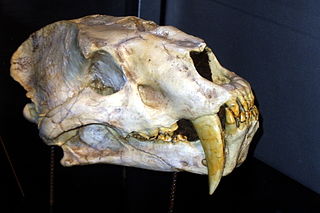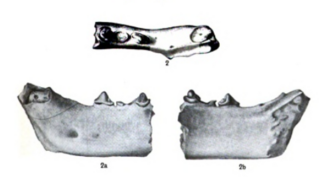
Pseudaelurus is a prehistoric cat that lived in Europe, Asia and North America in the Miocene between approximately twenty and eight million years ago. It is considered to be a paraphyletic grade ancestral to living felines and pantherines as well as the extinct machairodonts (saber-tooths), and is a successor to Proailurus. It originated from Eurasia and was the first cat to reach North America, when it entered the continent at about 18.5 Ma ending a 'cat-gap' of 7 million years. The slender proportions of the animal, together with its short, viverrid-like legs, suggest that it may have been an agile climber of trees.

Ailuridae is a family in the mammal order Carnivora. The family consists of the red panda and its extinct relatives.
Paramachaerodus is an extinct genus of saber-tooth cat of the subfamily Machairodontinae, which was endemic to Europe and Asia during the Middle and Late Miocene from 15 to 9 Ma. A 2022 phylogenetic analysis suggested that the genus may be polyphyletic.

Pachycrocuta is an extinct genus of prehistoric hyenas. The largest and most well-researched species is Pachycrocuta brevirostris, colloquially known as the giant short-faced hyena as it stood about 90–100 cm (35–39 in) at the shoulder and it is estimated to have averaged 110 kg (240 lb) in weight, approaching the size of a lioness, making it the largest known hyena. Pachycrocuta first appeared during the late Miocene. By 800,000 years ago, it became locally extinct in Europe, with it surviving in East Asia until at least 500,000 years ago, and possibly later elsewhere in Asia. There is a possibility the extant brown hyena is a member of this genus, along with the extinct Pliocrocuta and "Hyaena" prisca.

Ailuropodinae is a subfamily of Ursidae that contains only one extant species, the giant panda of China. The fossil record of this group has shown that various species of pandas were more widespread across the Holarctic, with species found in places such as Europe, much of Asia and even North America. The earliest pandas were not unlike other modern bear species in that they had an omnivorous diet but by around 2.4 million years ago, pandas have evolved to be more herbivorous.

Amphicyon is an extinct genus of large carnivorans belonging to the family Amphicyonidae, subfamily Amphicyoninae, from the Miocene epoch. Members of this family received their vernacular name for possessing bear-like and dog-like features. They ranged over North America, Europe, Asia, and Africa.

Percrocuta is an extinct genus of hyena-like feliform carnivores. It lived in Europe, Asia, and Africa, during the Miocene epoch.

Protictitherium is an extinct genus of hyena that lived across Europe and Asia during the Middle and Late Miocene, it is often considered to be the first hyena since it contains some of the oldest fossils of the family. They were especially prolific in Turkey, where every species has been registered.

Barbourofelidae is an extinct family of carnivorans of the suborder Feliformia, sometimes known as false saber-toothed cats, that lived in North America, Eurasia and Africa during the Miocene epoch and existed for about 7.9 million years. Thought to be an independent lineage from the Nimravidae and Machairodontinae, which had all attained elongated canines, recent research argues that it may be a subfamily of the Nimravidae, extending its biochronological range into the Miocene, although this issue is not yet fully resolved.
Ginsburgsmilus is an extinct genus of carnivorous mammal of the family Barbourofelidae that was endemic to Africa during the early Miocene. There is only one known specimen of Ginsburgsmilus napakensis, dated to 20-19 mya.

Amphimachairodus is an extinct genus of large machairodonts. It is also a member of the tribe Homotherini within Machairodontinae and is most closely related to such species as Xenosmilus, Homotherium itself, and Nimravides. It inhabited Eurasia, Northern Africa and North America during the late Miocene epoch.

Pliopithecoidea is an extinct superfamily of catarrhine primates that inhabited Asia and Europe during the Miocene. Although they were once a widespread and diverse group of primates, the pliopithecoids have no living descendants.
Yoshi is an extinct genus of machairodontine sabertooth cat in the tribe Metailurini. Its fossils were described from Turolian deposits from the Miocene epoch of the Balkan Peninsula in 2014 and specimens from China once thought to belong to Metailurus. The name comes from that of the lead author's pet cat. It has been described as potentially being synonymous with Metailurus, though this is difficult to confirm at present. The type specimen is a skull that bears remarkable similarities with the modern cheetah. Yoshi is intermediate in size between a lynx and cougar, and based on several as-yet unpublished skeletons, may have had a similar lifestyle to the cheetah, being better built for speed and fast pursuit than most other machairodonts, which were more suited to ambush and hunting large, relatively slow moving animals.

Eomellivora is an extinct genus of prehistoric mustelids, closely related to the honey badger, known from Eurasia and North America, and tentatively Africa. It was one of the biggest mustelids ever known, bigger and more hypercarnivorous than the modern wolverine.
Sivapanthera is a prehistoric genus of felid described by Kretzoi in 1929. Species of Sivapanthera are closely related to the modern cheetah but differ from modern cheetahs by having relatively longer brain cases, flatter foreheads, narrower nostrils and larger teeth. In many ways, skulls of Sivapanthera show similarity to that of the puma, or even those of Panthera. Scholars differ on the validity of this genus, while some think that it should be treated as a distinct genus, others think that its members should be treated as members of the Acinonyx genus, or even as subspecies of Acinonyx pardinensis.
Styriofelis is an extinct genus of Felidae known from the Miocene of Europe.
Hyperailurictis is an extinct genus of felid from Miocene North America. The Hyperailurictis species are Pseudaelurus-grade felids and thought to be the first felids in the Americas.
Miopanthera is an extinct genus of Pseudaelurus-grade felids.
Sivaelurus is a fossil genus of felid containing only a single species, S. chinjiensis, which was described based on a partial right maxilla collected from the Chinji Formation in the Lower Siwaliks. The species was originally described by Guy Ellcock Pilgrim as Pseudaelurus chinjiensis in 1910, who later erected a new genus, Sivaelurus, for it in 1913.

Sivasmilus is a fossil genus of barbourofelid containing only a single species, Sivasmilus copei. It is known from only a single specimen, a partial mandible collected from the Chinji Formation in the Lower Siwaliks in Pakistan, estimated to be from the Miocene. The fossil was originally described in 1915 when it was assigned to the fossil feline Sivaelurus chinjiensis, but was used as the basis of a new genus and species in 1929 by Hungarian paleontologist Miklós Kretzoi. Sivasmilus copei was a relatively small, cat-like animal.












